| Wednesday, 03 December 2025 |
|
|
| AUTO INFO |
|
|
| << back |
TECHNICAL REQUIREMENTS FOR AUTOMOBILES PARTICIPATE IN COMPETITIONS
APPENDIX "J" TO THE FIA INTERNATIONAL SPORTING CODE |
| Article 252 - General Prescriptions |
| |
|
ARTICLE 1 : GENERAL REMARKS
1.1 All modifications are forbidden unless expressly authorised
by the regulations specific to the group in which the car is entered or
by the general prescriptions below or imposed under the chapter "Safety
Equipment". The components of the car must retain their original function.
1.2 Application of the general prescriptions The general prescriptions
must be observed in the event that the specifications of Production Cars
(Group N), Touring Cars (Group A), Grand Touring Cars (Group B) do not
lay down a more strict prescription.
1.3 Material The use of a material which has a specific yield modulus
greater than 40 GPa/g/cm 3 is forbidden for the making of all the parts
that are free or homologated as a Variant-Option. This restriction does
not concern the parts homologated with the standard vehicle. The use of
magnesium alloy sheet metal with a thickness less than 3 mm is prohibited.
1.4 It is the duty of each competitor to satisfy the Scrutineers
and the Stewards of the meeting that his automobile complies with these
regulations in their entirety at all times during the event.
1.5 Damaged threads can be repaired by screwing on a new thread
with the same interior diameter ("helicoil" type).
1.6 Any Group A car, homologated after 01.01.99, with the exception
of kit variants, and competing in rallies must not be wider than 1770
mm. Group N cars may compete in their integral version.
ARTICLE 2 : DIMENSIONS AND WEIGHT
2.1 Ground clearance No part of the car must touch the ground when
all the tyres on one side are deflated. This test shall be carried out
on a flat surface under race conditions (occupants on board).
2.2 Ballast It is permitted to complete the weight of the car by
one or several ballasts provided that they are strong and unitary blocks,
fixed by means of tools with the possibility to fix seals, placed on the
floor of the cockpit, visible and sealed by the scrutineers. Application:
Touring Cars (Group A), Grand Touring Cars (Group B) ; no kind of ballast
is authorised in Production Cars (Group N). In rallies, however, the carrying
of tools and spare parts for the car will be allowed under the conditions
laid down in article 253.
ARTICLE 3 : ENGINE
3.1 Supercharging In case of supercharging, the nominal cylinder-capacity
will be multiplied by 1.7 for petrol engines and by 1,5 for diesel engine,
and the car will pass into the class corresponding to the fictive volume
thus obtained. The car will be treated in all respects as if its cylinder-capacity
thus increased were its real capacity. This shall particularly be the
case for assigning the car to its cylinder-capacity class, its interior
dimensions, its minimum number of places, its minimum weight, etc.
3.2 Equivalence formula between reciprocating piston and rotary engines
(of the type covered by the NSU Wankel patents) The equivalent cubic capacity
is equal to the volume determined by the difference between the maximum
and minimum capacities of the combustion chamber.
3.3 Equivalence formula between reciprocating piston and turbine engines
The formula is the following:
C = ( S(3.10 x R) - 7.63 ) / 0.09625
S = High pressure nozzle area - expressed in square centimetres by which
is meant the area of the airflow at the exit from the stator blades (or
at the exit from the first stage if the stator has several stages).
Measurement is done by taking the area between the fixed blades of the
high-pressure turbine first stage.
In cases where the first stage turbine stator blades are adjustable, they
must be opened to their greatest extent.
The area of the high-pressure nozzle is thus the product of the height
(expressed in cm) by the width (expressed in cm) and by the number of
blades.
R = The pressure ratio is the ratio of the compressor of the turbine engine.
It is obtained by multiplying together the value for each stage of the
compressor, as indicated hereafter:
Subsonic axial compressor: 1.15 per stage
Trans-sonic axial compressor: 1.5 per stage
Radial compressor: 4.25 per stage.
Thus a compressor with one radial and six axial subsonic stages will be
designated to have a pressure ratio of:
4.25 x 1.15 x 1.15 x 1.15 x 1.15 x 1.15 x 1.15 or 4.25 x (1.15) ^6 .
C = Equivalent cubic capacity for reciprocating piston engines in cm ^3
.
3.4 All engines into which fuel is injected or in which fuel is
burned after an exhaust port are prohibited.
3.5 Equivalencies between reciprocating piston engines and new types
of engines The FIA reserves the right to make modifications on the
basis of comparisons established between classic engines and new types
of engines, by giving a two-year notice from the 1st January following
the decision taken.
3.6 Exhaust system and silencer Even when the specific provisions
for a group allow the replacement of the original silencer, the cars competing
in an open-road event shall always be equipped with an exhaust silencer
complying with the traffic regulations of the country(ies) through which
the event is run.
For all cars used in Rallies and unless the limits imposed by the local
authorities are lower, the noise level on the open road must not exceed
103 dB(A) for an engine rotation speed of 3500 rpm for petrol engines
and 2500 rpm for diesel engines.
The orifices of the exhaust pipes shall be placed at a maximum of 45 cm
and a minimum of 10 cm from the ground.
The exit of the exhaust pipe must be situated within the perimeter of
the car and less than 10 cm from this perimeter, and aft of the vertical
plane passing through the centre of the wheelbase.
Moreover, adequate protection must be provided in order to prevent heated
pipes from causing burns.
The exhaust system must not be provisional.
Exhaust gas may only exit at the end of the system.
Parts of the chassis must not be used to evacuate exhaust gasses.
Catalytic exhausts:
Should two possible versions of one car model be homologated (catalytic
and other exhaust), the cars must comply with one or other version, any
combination of the two versions being prohibited.
All cars equipped with a kit (VK) must be fitted with a homologated catalytic
exhaust.
For all groups, all cars must be fitted with a homologated catalytic exhaust
if this is obligatory in the country in which they are registered, unless
the catalytic exhaust is not obligatory in the organising country, in
which case it may be removed.
3.7 Starting on board the vehicle Starter with electric or other
source of energy on board operable by the driver when seated in the seat.
3.8 Cylinders For non-sleeved engines, it will be possible to repair
the cylinders by adding material, but not parts.
ARTICLE 4 : TRANSMISSION
All cars must be fitted with a gearbox including a reverse gear which
must be in working order when the car starts the event, and be able to
be operated by the driver when he is normally seated.
ARTICLE 5 : SUSPENSION
Suspension parts made partially or entirely from composite materials are
prohibited.
ARTICLE 6 : WHEELS
Wheels made partially or entirely from composite materials are prohibited.
Measuring wheel width:
The width is to be measured with the wheel mounted on the car, on the
ground, the vehicle in race condition, driver aboard, at any point along
the circumference of the tyre, except in the area in contact with the
ground.
When multiple tyres are fitted as part of a complete wheel, the latter
must comply with the maximum dimensions for the Group in which these tyres
are used (see article 255.5.4 and article 256.5).
ARTICLE 7 : COACHWORK
7.1 Convertible vehicles must comply in all respects with the specifications
applying to open cars.
7.2 Minimum inside dimensions If a modification authorised by Appendix
J affects a dimension stated on the homologation form this dimension may
not be retained as an eligibility criterion for the car.
7.3 Cockpit Only the following accessories may be installed in
the cockpit: spare wheels, tools, spare parts, safety equipment, communication
equipment, ballast (if permitted), windscreen washer water container (Touring
Cars (Group A) and Grand Touring Cars (Group B) only). The passenger area
and seat of an open car must in no way be covered.
Containers for helmets and tools situated in the cockpit must be made
of non-inflammable material and they must not, in case of fire, give off
toxic vapours.
The original fitting of the air bags may be removed, without modifying
the appearance of the bodywork.
7.4 All body panels of the vehicle must be at all times of the
same material as those of the original homologated car and must be of
the same material thickness as that of the original homologated car (tolerance
± 10 %).
7.5 Headlamp mounting and protection The boring of holes in the
front bodywork for light brackets is authorised, limited solely to mountings.
In rallies, non-reflecting protectors made from flexible material may
be mounted on the headlamps ; they must not protrude forwards beyond the
headlamp glass by more than 10 cm.
7.6 Any object of a dangerous nature (battery, inflammable
products, etc.) must be carried outside the cockpit.
7.7 Mud flaps (in Rallies only)
If the supplementary regulations of the event authorise them or impose
them, transversal mud flaps will be accepted under the following conditions:
- They must be made from flexible material.
- They must cover at least the width of each wheel, but at least one third
of the width of the car (see drawing 252-6) must
be free behind the front wheels and the rear wheels.
|
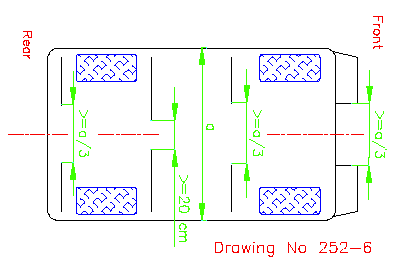 |
|
- There must be a gap of at least 20 cm between the right and left mud
flaps in front of the rear wheels.
- The bottom of these mud flaps must be no more than 10 cm from the ground
when the car is stopped, with nobody on board.
- In vertical projection, these mud flaps must not protrude beyond the
bodywork.
Mud flaps to prevent splashing towards the front, made from flexible material,
may be installed at the front of the vehicle, if the supplementary regulations
of the event authorise them or impose them.
They must not protrude beyond the overall width of the vehicle, or beyond
the original overall length by more than 10 cm, and at least one third
of the width of the car must be free in front of the front wheels.
ARTICLE 8 : ELECTRICAL SYSTEM
8.1 Lighting A fog light may be changed for another light, and
vice versa, provided that the original mounting remains the same.
8.2 The mounting of the alternator is free.
8.3 Horn In rallies only, the noise level produced by the horn
must be greater than or equal to 97 dB during at least 3 seconds, measured
7m in front of the vehicle.
ARTICLE 9 : FUEL - COMBUSTIVE
9.1 The fuel must be commercial petrol which comes from a service
station pump, without any additive other than that of a lubricant on current
sale. The fuel must comply with the following specifications:
- 102.0 RON and 90.0 MON maximum, 95.0 RON and 85.0 MON minimum for unleaded
fuel.
100.0 RON and 92.0 MON maximum, 97.0 RON and 86.0 MON minimum for leaded
fuel.
The measurements will be made according to the standards ASTM D 2699-86
and D 2700-86.
- Specific gravity between 720 and 785 kg/m 3 at 15°C (measured according
to ASTM D 4052).
- A maximum of 2.8 % oxygen (or 3.7 % if the lead content is less than
0.013 g/l) and 0.5 % nitrogen by weight, the remainder of the fuel consisting
exclusively of hydrocarbons and not containing any power-boosting additives.
The measuring of the nitrogen content will be carried out according to
the standard ASTM D 3228 and that of the oxygen content by elemental analysis
with a tolerance of 0.2 %.
- Maximum content of peroxides and nitrooxide compounds: 100 ppm (ASTM
D 3703 or in the case of impossibility UOP 33- 82).
- Maximum lead content: 0.40 g/l or the standard of the country of the
event if it is lower (ASTM D 3341 or D 3237).
- Maximum benzene content: 5 % in volume (ASTM D 3606).
- Maximum Reid vapour pressure: 900 hPa (ASTM D 323).
- Distillation at 70°C: 10 % -47 % (ASTM D 86).
- Distillation at 100°C: 30 % - 70 % (ASTM D 86).
- Distillation at 180° C: 85 % minimum (ASTM D 86).
- Maximum final boiling point: 225°C (ASTM D 86).
- Maximum residue: 2 % volume (ASTM D 86).
The fuel being accepted or rejected according to the standard ASTM D 3244
with a confidence limit of 95 %.
For vehicles with a catalytic converter, leaded petrol is forbidden.
If the fuel available locally for the event is not of a sufficient quality
for use by competitors, the ASN of the organising country must ask the
FIA for a waiver in order to enable the use of fuel not corresponding
to the characteristics defined above.
9.2 Diesel
For Diesel engines, the fuel must be gas oil corresponding to the following
specifications:
- Hydrocarbon level, % by weight 99.0 min.
- Specific gravity, kg/m 3 860 max.
- Cetane number (ASTM D 613) 55 max.
- Calculated cetane number 55 max.
(ASTM D 976-80)
9.3 Only air may be mixed with the fuel as an oxidant.
9.4 Refuelling procedure Standardised coupling - In case of a centralised
system provided by the circuit or a system provided by the competitors,
the refuelling hose shall be provided with a leak-proof coupling to fit
the standardised filler mounted on the car (in accordance with drawing
252-5; the interior diameter D must not exceed 50
mm).
|
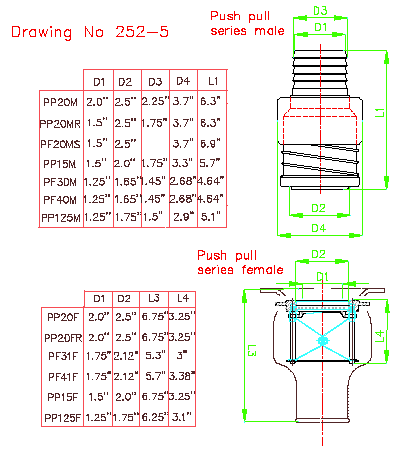 |
|
- All cars must be provided with a fuel filler complying with this diagram.
This leak-proof fitting must comply with the dead man principle and must
not therefore incorporate any retaining device when in an open position
(spring-loaded, bayonet, etc.).
- The air vent(s) must be equipped with non return and closing valves
having the same closing system as that of the standard filler and having
the same diameter.
During refuelling the outlets of the air-vents must be connected with
the appropriate coupling either to the main supply-tank or to a transparent
portable container with a minimum capacity of 20 litres provided with
a closing system rendering it completely leak-proof.
The venting catch tanks must be empty at the beginning of the refuelling
operation.
In the cases where the circuits are unable to provide the entrants with
a centralised system, they will have to refuel according to the above
procedure.
The level of the reserve tank may in no case be more than 3 metres above
the level of the track where the refuelling is effected.
This applies to the whole duration of the event.
The overflow bottles must conform to one of the drawings 252-1
or 252-2.
|
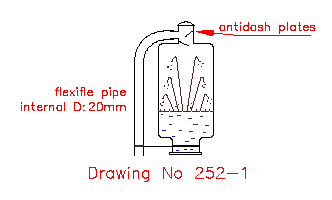 |
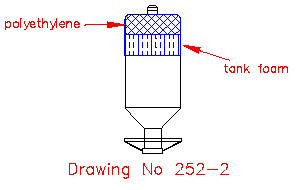 |
|
The reserve tank and all metal parts of the refuelling system from the
coupling over the flow meter up to the tank and its rack must be connected
electrically to the earth.
The application of the following is recommended:
1. Each pit should be equipped with two aircraft type grounding connections.
2. The refuelling system (including tower, tank, hose, nozzle, valves
and vent bottle) should be connected to one of the above grounding connections
for the entire duration of the race.
3. The car should be connected, at least momentarily, to the other grounding
connection as soon as it stops in the pit.
4. No fuel hose connection (fill or vent) unless and until conditions
2 and 3 have been fulfilled.
5. All fuel-handling pit crew members should wear non-static protective
clothing.
The refuelling tank may be one of the following:
- models made of rubber, of the type FT3 or FT3 1999, built by an approved
manufacturer, or
- tanks conforming to one of the drawings 252-3
or 252-4.
|
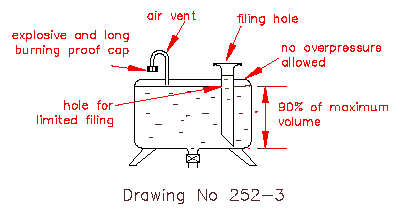 |
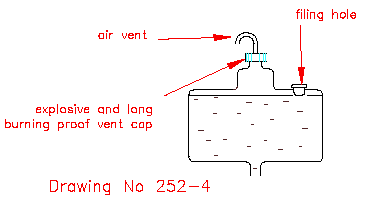 |
|
Application: For Touring Cars (Group A), Grand Touring Cars (Group B),
refer to the general prescriptions of the FIA Championships.
9.5 Tank ventilation It is authorised to equip a tank with ventilation
exiting through the car roof.
9.6 Installation of the FT3 or FT3 1999 tank The FT3 or FT3 1999
tank may be placed either in the original location of the tank or in the
luggage compartment. There must be an orifice to evacuate any fuel which
may have spread into the tank compartment. The position and the dimension
of the filler hole as well as that of the cap may be changed as long as
the new installation does not protrude beyond the bodywork and guarantees
that no fuel shall leak into one of the interior compartments of the car.
If the filler hole is situated inside the car, it must be separated from
the cockpit by a liquid-tight protection.
ARTICLE 10 : BRAKES
Carbon brake discs are forbidden.
|
| |
|
| top |
|
|
|
|


